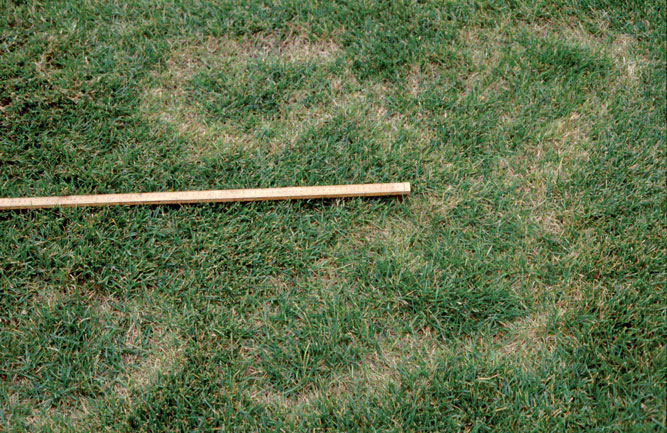How to eliminate necrotic ring spot this spring

Experts recommend removing up to six inches of asymptomatic turf around each necrotic ring spot area. (Photo: Tom Hsiang)
If your course has Kentucky bluegrass, you’ve likely encountered necrotic ring spot (NRS) at some point in time, as it’s mainly a disease of that specific turfgrass. Experts also say it’s less commonly found on other types of turf.
Not only that, but experts say it thrives in wet environments, especially those frequently irrigated. To help you slow NRS’s growth — or possibly even eliminate it — Tom Hsiang, Ph.D. plant pathologist and professor at the University of Guelph’s School of Environmental Sciences, shares methods you can deploy.
Water less, cut higher

Tom Hsiang
According to Hsiang, superintendents must reduce irrigation on their courses’ Kentucky bluegrass. At the same time, they should also maintain higher mowing heights for Kentucky bluegrass, noting the lowest should be no less than two inches tall.
NRS is a perennial root disease persistent on the same patch of infected turf every year. Not only does it attack and grow on roots, but it also causes unsightly rings that are difficult to remove, as damage usually occurs before the disease is ever visible.
“It develops slowly and might not appear for months after roots were first infected,” Hsiang says.
It’s vital to prevent NRS from developing in the first place. But if it’s already too late for your course, you have another option for removal: physically dig out and remove disease patches. If you choose to do this, you should also remove some non-symptomatic turf around each ring; Hsiang recommends up to
six inches.
Additionally, apply fungicides with azoxystrobin, iprodione, trifloxystrobin, fluxapyroxad or pyraclostrobin. Make applications in April or May when soil temperatures range between 55 and 65 degrees Fahrenheit.
“Far too often, fungicides are applied when symptoms are first seen during the summer,” Hsiang stresses. “They generally have little effect because the fungus may be dormant at that time. Deliver fungicides to the root zone area at the proper time of year, and you will reduce, or even eliminate, your course’s NRS long term.”

Ben Pease
The Andersons
Ben Pease
Turfgrass agronomist
NRS can be misdiagnosed as a localized dry spot during its early stages, as symptoms of both issues often occur during the summer. Initial visual symptoms are leaf dieback beginning at the tip, followed by a collapse of the entire plant. Roots will be stunted or necrotic. Patches begin at 6 to 8 inches in diameter and enlarge or coalesce over time. As the turf recovers, a distinctive “frog-eye” pattern emerges of healthy green turf in the center, surrounded by dead turf. Cultural practices can be employed to minimize the visual effects of infection. Because NRS is a root stunting disease, any practices to promote deep rooting will decrease infection symptoms. Steps to relieve summer stresses will also help. Chemical control is possible via liquid or granular fungicide applications. Multiple applications will likely be needed for extended control, the most effective of which are thiophanate-methyl or various DMI and QoI fungicides. Granular control options include 3336 DG Lite and 0.72G Prophesy DG Pro.

John Perry
Greene County Fertilizer Co.
John Perry
President, founder and CEO
Necrotic ring spot can be a frustrating disease to deal with in turfgrass, especially when we are talking about areas of high traffic or high play. There are only a few fungicides that have shown very positive results in trials, and one of those is fenarimol. The timing of the application is critical. If applied too early, the effectiveness of the fungicide will be worn off before the disease propagates. If applied too late in the season, the application will have little to no effect. Beginning in mid-to-late spring, fungicide applications tend to have the best efficacy. Proper fertilization, aeration of the infected spots and carefully monitored irrigation practices are your best defenses. Another excellent choice, if conditions persist, is to plant resistant cultivars as areas are recovering. Other options that have shown anecdotal results are acidic pH changes and biostimulants to enhance root development. As always, the best defense is proactive cultural practices.

Leah Brilman, Ph.D
DLF Pickseed/Seed Research of Oregon
Leah Brilman, Ph.D
Director of research and technical services
Necrotic ring spot is a difficult disease to manage in Kentucky bluegrass. As a root infecting fungus, the symptoms often appear after the disease has significantly damaged roots. The usual recommendation is to plant resistant cultivars. However, ratings for resistance have been extremely variable from site to site. Most cultivars (stated as resistant) are no longer available, and National Turfgrass Evaluation Program (NTEP) ratings haven’t been conducted since 2010. Consider initially overseeding blends with cultivars that have shown resistance in NTEP trials.
Additionally, overseed with perennial ryegrass or turf-type tall fescue — which have resistance. To help mediate damage, utilize moderate nitrogen and add sulfur to your stand. Also, apply fungicides during spring when soil temperatures are appropriate and water well.












